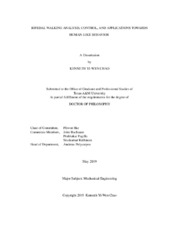| dc.contributor.advisor | Hur, Pilwon | |
| dc.creator | Chao, Kenneth Yi-wen | |
| dc.date.accessioned | 2019-10-15T15:47:14Z | |
| dc.date.available | 2019-10-15T15:47:14Z | |
| dc.date.created | 2019-05 | |
| dc.date.issued | 2019-01-14 | |
| dc.date.submitted | May 2019 | |
| dc.identifier.uri | https://hdl.handle.net/1969.1/183859 | |
| dc.description.abstract | Realizing the essentials of bipedal walking balance is one of the core studies in both robotics and biomechanics. Although the recent developments of walking control on bipedal robots have brought the humanoid automation to a different level, the walking performance is still limited compared to human walking, which also restricts the related applications in biomechanics and rehabilitation.
To mitigate the discrepancy between robotic walking and human walking, this dissertation is broken into three parts to develop the control methods to improve three important perspectives: predictive walking behavior, gait optimization, and stepping strategy. To improve the predictive walking behavior captured by the model predictive control (MPC) which is transitionally applied with the nonlinear tracking control in sequence, a quadratic program (QP)-based controller is proposed to unify center of mass (COM) planning using MPC and a nonlinear torque control with control Lyapunov function (CLF). For the gait optimization, we focus on the algorithms of trajectory optimization with direct collocation framework. We propose a robust trajectory optimization using step-time sampling for a simple walker under terrain uncertainties. Towards generating human-like walking gait with multi-domain (phases), we improve the optimization through contact with more accurate transcription method for level walking, and generalize the hybrid zero dynamics (HZD) gait optimization with modified contact conditions for walking on various terrains. The results are compared with human walking gaits, where the similar trends and the sources of discrepancies are identified. In the third part for stepping strategy, we perform step estimation based on capture point (CP) for different human movements, including single-step (balance) recovery, walking and walking with slip. The analysis provides the insights of the efficacy and limitation of CP-based step estimation for human gait. | en |
| dc.format.mimetype | application/pdf | |
| dc.language.iso | en | |
| dc.subject | bipedal locomotion | en |
| dc.subject | balance control | en |
| dc.subject | zero moment point | en |
| dc.subject | center of pressure | en |
| dc.subject | quadratic program-based control | en |
| dc.subject | control Lyapunov function | en |
| dc.subject | model predictive control | en |
| dc.subject | trajectory optimization | en |
| dc.subject | direct collocation | en |
| dc.subject | robust trajectory optimization | en |
| dc.subject | hybrid zero dynamics | en |
| dc.subject | stepping strategy | en |
| dc.subject | capture point | en |
| dc.subject | instantaneous capture point | en |
| dc.title | Bipedal Walking Analysis, Control, and Applications Towards Human-Like Behavior | en |
| dc.type | Thesis | en |
| thesis.degree.department | Mechanical Engineering | en |
| thesis.degree.discipline | Mechanical Engineering | en |
| thesis.degree.grantor | Texas A & M University | en |
| thesis.degree.name | Doctor of Philosophy | en |
| thesis.degree.level | Doctoral | en |
| dc.contributor.committeeMember | Buchanan, John | |
| dc.contributor.committeeMember | Pagilla, Prabhakar | |
| dc.contributor.committeeMember | Rathinam, Sivakumar | |
| dc.type.material | text | en |
| dc.date.updated | 2019-10-15T15:47:15Z | |
| local.etdauthor.orcid | 0000-0002-8408-4509 | |


